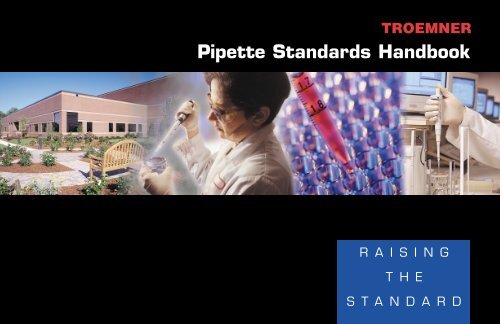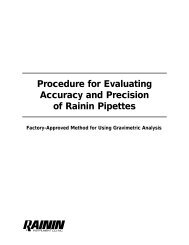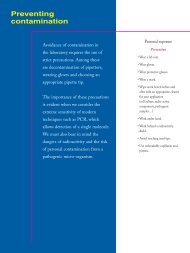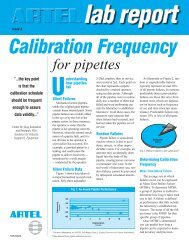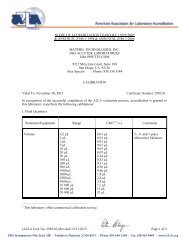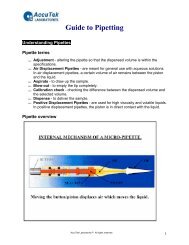Pipette Standards Handbook - Pipette.com
Pipette Standards Handbook - Pipette.com
Pipette Standards Handbook - Pipette.com
You also want an ePaper? Increase the reach of your titles
YUMPU automatically turns print PDFs into web optimized ePapers that Google loves.
TROEMNER<strong>Pipette</strong> <strong>Standards</strong> <strong>Handbook</strong>R A I S I N GT H ES T A N D A R D
TROEMNERTable of ContentsIntroduction ..........................................................2Regulations and <strong>Standards</strong> ....................................5Types of <strong>Pipette</strong>s ..................................................10Proper Pipetting Techniques....................................14Methods of Calibration ..........................................21Factors Affecting Calibration ..................................24Servicing and Calibration Process ............................29Commonly asked Questions ....................................33Terminology ..........................................................371
IntroductionTroemner is pleased to offer the<strong>Pipette</strong> <strong>Standards</strong> <strong>Handbook</strong> to helpclarify misconceptions surroundingproper techniques, operation, andcalibration of these instruments.In a world of powerful analyticalinstrumentation, volumetric liquidhandling is an area that is sometimesforgotten. Anyone, who uses pipettesconsistently in their work, shouldfind this publication a helpful andpractical aid.This publication presents theconcepts and practices acceptedand employed by a majority ofmetrological and scientificindividuals that are pertinent tocurrent calibration practices andproper pipetting techniques.Obviously, when working in anaccredited or other externallyregulated environment, not only isSECTION 1:INTRODUCTIONit important for the calibrationto be accurate, but it must also havean appropriate data-trail. This isbe<strong>com</strong>ing increasingly importantas laboratories apply for ISO/ENaccreditation, and also in light ofthe recent classification of pipettesas medical devices by the DINstandard authority, acknowledgingtheir crucial position in themanual performance of clinicaldiagnostic tests.2SECTION 1:INTRODUCTION3
SECTION 1:INTRODUCTIONTroemner was founded over160 years ago in 1838 by HenryTroemner. The <strong>com</strong>pany started as amanufacturer of scales and weightsin Philadelphia.Today,Troemner is anISO 9001 registered <strong>com</strong>pany and isthe world's leading supplier ofprecision weights and massstandards. We manufacture andcertify weights that meet or exceedthe highest tolerance standards ofthe American Society for Testing &Materials (ASTM) and theInternational Organization of LegalMetrology (OIML). Since 1995,Troemner’s laboratories have beenaccredited by the United KingdomAccreditation Service (UKAS,formerly known as NAMAS) and theNational Voluntary LaboratoryAccreditation Program (NVLAP)which is sponsored and administeredby the National Institute of <strong>Standards</strong>and Technology (NIST).Troemneroffers either NIST/NVLAP or UKAScertification for precision weights.Troemner’s strong background inboth metrology and mass calibrationsmade the decision to transition intothe pipette calibration arena an easyone. Troemner is currently the only<strong>com</strong>pany in the United Statesaccredited by NIST/NVLAP forpipette calibrations. Our highlytrained technicians perform allcalibrations and strive to continueto improve methods and techniquesto reduce our measurementuncertainties.Regulations and <strong>Standards</strong>4SECTION 2:REGULATIONSAND STANDARDS
SECTION 2:REGULATIONSAND STANDARDSThere are several qualityregulations pertaining tovolumetric instrumentation andgravimetric pipette calibrations thatare worth mentioning, since thesedocuments essentially set thestandards. They are as follows:1) DIN Standard 12650 1 –The Standard Committeefor Laboratory Devices andEquipment in the DIN (GermanInstitute for Standardization)determines the regulations forconformity testing and certification.The latest draft (4thStandard Proposal, 1996-07) issubdivided into specific sections.– DIN 12650-1: GeneralRequirements– DIN 12650-2: Piston-strokepipettes– DIN 12650-3: Dispensers– DIN 12650-4: Diluters– DIN 12650-5: Piston burettes– DIN 12650-6: Gravimetric testingfor measuring accuracy– DIN 12650-7: Non-gravimetrictest methods– DIN 12650-8: MultichannelpipettesThe DIN standard describes the workinvolved with dispensing systems,stipulates requirements in respect tophysical properties, and lists detailedinstructions for testing accuracy andprecision of dispensing systems. TheDIN standard also includes detailsof admissible limits of error for thevarious dispensing systems.“Maximum Permitted Errors” isdefined as the inaccuracy plus twicethe standard deviation.The error limits are always based onthe overall system of the pipette andthe tip together. The error limitsof pipettes with a nominal volumebetween the nominal volumesgiven in the table must correspondto the relative error limits for thenext-highest nominal volume. If theFIXED-VOLUME PIPETTES AND VARIPETTESNominal volume ul 1 2 5 10 20Error limit + ul 0.15 0.2 0.3 0.3 0.4Nominal volume ul 50 100 200 500 1000Error limit + ul 0.8 1.5 2 5 10Nominal volume ul 2000 5000 10000Error limit + ul 20 50 100MULTI-CHANNEL PIPETTESNominal volume ul 1 2 5 10 20Error limit ± ul 0.3 0.4 0.6 0.6 0.8Nominal volume ul 50 100 200 500 1000Error limit ± ul 1.6 3 4 10 20Nominal volume ul 2000Error limit ± ul 40DISPENSERS AND MULTIPETTE PIPETTESNominal volume ul 10 20 50 100 500Error limit ± ul 0.5 0.8 1.5 2 10Nominal volume ul 2000 >5000Error limit ± ul 10 40SECTION 2:REGULATIONSAND STANDARDSnominal volume of the pipette is exactly betweentwo nominal volumes given in the table, the relativeerror limit for the lower volume is acceptable.The error limits in accordance with the latest versionof the DIN 12650 standard based on volume areas follows:Variable pipettes must meet the standards of fixedpipettes at their maximum volume,no matter what theirsetting.Thus,a variable 100ul pipette set at 10ul may have up toa 1.5 ul total error.Foot note: 1. DIN Standard 12650–Available from: Henry Troemner, LLC, 201 Wolf Drive, P.O. Box 87,Thorofare, NJ 08086-0087 or Deutscites institut Für Normung, DIN/DQS Technorga GmbH,Kamekestr.8, D-50672 köh*Note:Values given in the DIN Table are for factory or factory workshop testing.Users who test their own pipettes should meet twice the listed standards.67
SECTION 2:REGULATIONSAND STANDARDSSECTION 2:REGULATIONSAND STANDARDS2) ASTM E1154-89 2 – This specificationcovers requirements,operating conditions, and testmethods for piston or plungeroperated volumetric apparatus.3) ISO Guide 25 3 (proposed revision:ISO/IEC IS 17025) – This guidesets out the general provisionswhich a laboratory must addressto carry out specific calibrationsor tests. ISO Guide 25 providesthe laboratories direction for thedevelopment and implementationof a fundamental qualitymanagement system.4) ISO 3696 4 – This standard pertainsto the specifications of the waterused during the calibrationprocedure. It sets maximumresistivity,TOC (total organiccarbon), absorbance, and silicacontent values. In order toestablish <strong>com</strong>pliance, the watermust be within the enumeratedparameters.5) GLP <strong>Standards</strong> 5 - Good LaboratoryPractices (GLPs) not only addressthe organizational aspects ofoperation and the conditionsunder which laboratory tests arescheduled, conducted, andmonitored; but, also, the aspectof recording and reportingtest results. GLP principlesare basically used for testingsubstances and acquiring dataon their properties and/or theirharmlessness to human healthand the environment.6) European Parliament directive onin vitro diagnostic products 6 – Thisdirective was issued in line withthe harmonization of individualEuropean state legislation and itstipulates minimum requirementsfor the free movement of in vitrodiagnostic products within itsareas of jurisdiction.7) NIST/NVLAP 7 – The NationalVoluntary Laboratory AccreditationProgram (NVLAP),sponsored by the NationalInstitute of <strong>Standards</strong> andTechnology (NIST), assessesand accredits organizationsbased on their technical abilityand quality system, following ISOGuide 25 (proposed revision:ISO/IEC IS 17025).8) NCCLS 8 – The National Committeefor Clinical Laboratory <strong>Standards</strong>(NCCLS) is a globally recognized,voluntary consensus, standardsdevelopingorganization thatenhances the value of medicaltesting within the healthcare<strong>com</strong>munity through thedevelopment and disseminationof standards, guidelines, andbest practices.9) CAP 9 – The College of AmericanPathologists (CAP) is an organizationthat accredits in order toimprove the quality of clinicallaboratory services throughout theUnited States, through voluntaryparticipation, professional peerreview, education, and <strong>com</strong>pliancewith established performancestandards.10) CLIA 10 – The Clinical LaboratoriesImprovement Act (CLIA) is adocument that outlines minimumstandards for personnel, testing,and quality control for clinicallaboratories.8Foot notes: 2.ASTM E1154-89– Available from:Henry Troemner, LLC, 201 Wolf Drive, P.O. Box87,Thorofare, NJ 08086-0087 or AmericanSociety for Testing and Materials, 100 BarrHarbor Drive,West Conshohocken, PA19428-29593. ISO Guide 25–Available from: Henry Troemner,LLC, 201 Wolf Drive, P.O. Box 87,Thorofare, NJ08086-0087 or The International Organizationfor Standardization –Is Irue de Varembé, CasePostak 56, CH-1211 Genéve 20, Switzerland4. ISO 3696–Available from:The InternationalOrganization for Standardization –Is Irue deVarembé, Case Postak 56, CH-1211 Genéve 20,Switzerland5. GLP <strong>Standards</strong>–Available from: FDA (HFE-88),Office of Consumer Affairs, 5600 Fishers Lane,Rockville, MD 208576. European parliament directive on in vitrodiagnostic products - Available from:Allée duPrintemps, B.P. 1024/F, F-67070 Strasburg Cedex7. NIST/NVLAP–Available from: NationalVoluntary Laboratory Accreditation Program(NVLAP), Nationals Institute of <strong>Standards</strong> &Technology, 100 Bureau Drive, Stop 2140,Gaithersburg, MD 20899-21418. NCCLS–Available from: Henry Troemner, LLC,201 Wolf Drive, P.O. Box 87,Thorofare, NJ08086-0087 or National Committee for ClinicalLibrary <strong>Standards</strong>, 940 West Valley Road, Suite1400,Wayne, PA 19087-18989. CAP–Available from: Henry Troemner, LLC,201 Wolf Drive, P.O. Box 87,Thorofare, NJ08086-0087 or The College of AmericanPathologists, 325 Waukegan Road, Northfield, IL6009310. CLIA–Available from: US Department ofHealth & Human Services, Room 645-F, HubertH. Humphrey Bldg., 200 Independence Ave.,S.W.,Washington, DC 202019
Types of <strong>Pipette</strong>sThere are three basic types ofpipettes in use in the laboratorytoday: glass pipettes, air displacementpipettes, and positive displacementpipettes.1) Glass pipettes are volumetricpieces of glass calibrated todeliver a specific volume of liquid.They are scribed as either a TD(“to deliver”) or a TC (“tocontain”) instrument at a specifictemperature which is usually 20 o C.A. Most glass pipettes are scribed“to deliver” which means thatthe residual sample must notbe “blown out” whendispensing a reagent.B. <strong>Pipette</strong>s that are scribed “tocontain” should be “blown out”with some type of pipette bulb.These types of instruments arenormally only used to deliverSECTION 3:TYPES OFPIPETTESreagents to samples. They areseldom used to dispense an analyteinto a flask for dilution purposes.Also, these instruments are usuallymade of borosilicate glass and aretraditionally thrown away aftereach use. If the instrument is usedmultiple times, it can not be“calibrated” in the true sense ofthe word since the graduationsSECTION 3:TYPES OFPIPETTES11
SECTION 3:TYPES OFPIPETTESSECTION 3:TYPES OFPIPETTEScan not be removed. However,this instrument can be testedand “verified”.2) Air displacement pipettes arepipettes that have a piston in acylinder or capillary tube thatmoves to the appropriate positiononce the volume is set. When theoperating button is depressed tothe first stop, the piston expelsthe same volume of air that isindicated on the micrometersetting. Once the tip is immersedinto the liquid, the operatingbutton is released, which createsa partial vacuum that aspiratesthe specified volume into the tip.When the operating button isdepressed to the first stop again,theair dispenses the liquid. In orderto empty the tip <strong>com</strong>pletely, theoperating button is pressed tothe second or “blow out” stop. Thekey feature of an air displacementpipette is the fact that a specifiedvolume of air always remainsbetween the piston and the liquid.3) Positive displacement pipettes arealso pipettes that have a piston in acylinder or capillary tube thatmoves to the appropriate positiononce the volume is set. However,this type of pipette always has thepiston in direct contact with theliquid. Most customers that selectthese types of instruments do sobecause the liquids they arepipetting have different characteristicsthan that of water. Liquidswith a high vapor pressure willtend to evaporate inside thepipette and liquids with a higherdensity or viscosity will tend toexpand the column of air insidethe pipette. By using this type ofinstrument for these types ofapplications, the user will get amore accurate result than theywould if they had used an airdisplacement pipette. Sample-tosampleand cross-contaminationare kept to a minimum by usingmicrosyringe tips that aredisposable. The operation of thistype of pipette is very similar to anair displacement pipette with afew, very important exceptions.First, the piston moves to theappropriate position when thevolume is set, so when theoperating button is depressed tothe first stop, the piston descendsto the tip opening. When the tip isimmersed into the liquid and thebutton is released, the plunger israised creating a partial vacuumwhich causes the liquid to enterthe tip. Finally, when the operatingbutton is depressed again, thepiston descends, expelling liquidfrom the tip. Most people do notuse positive displacement pipettesroutinely because of both theadded cost of tips and sealsand the inconvenience ofchanging them.1213
SECTION 4:PROPER PIPETTINGTECHNIQUES AND TIPSProper Pipetting Techniques and TipsThere are many techniques andtips available that will optimize yourpipetting performance and increasethe reproducibility of your results.A brief description of each follows:The Equipment1) Tips - It is advocated that onlyhigh quality tips which optimizethe pipette’s performance beused. A high quality tip is one thathas a smooth uniform interiorwith straight even sides thatprevents the retention of liquidsand minimizes surface wetting.Also, the tip should have a clean,hydrophobic surface and aperfectly centered opening inorder to ensure the <strong>com</strong>pletedispensing of the sample. Thesetips should always securely interfacewith the nosecone, becauseif they do not fit correctly, theamount of liquid dispensed canbe dramatically influenced.2) Liquid Viscosity - Since the pipettewas originally factory calibratedusing water, any liquid that has aviscosity higher or lower thanwater will impact the volumedispensed. Viscosity differentialsshould be accounted for andtaken into consideration in orderto enhance the accuracy ofthe instrument.3) Container - The material ofconstruction for the extractionvessel is also important, sincesome materials tend to forcewater into a convex configurationwhile other materials force waterinto a concave configuration.SECTION 4:PROPER PIPETTINGTECHNIQUES AND TIPS15
SECTION 4:PROPER PIPETTINGTECHNIQUES AND TIPSSECTION 4:PROPER PIPETTINGTECHNIQUES AND TIPSObviously, this can impact theamount of liquid drawn intothe tip. A glass container isre<strong>com</strong>mended since it tends toforce water into a concave configurationwhich helps to reduceor eliminate variations due tothis effect.The Operator1) Technique - Most end users havea tendency to believe that thevolume delivery is <strong>com</strong>pletelydependent on the setting of themicrometer dial. Obviously, thisis not the case, since manyfactors associated with pipettes<strong>com</strong>e into play.• Position - <strong>Pipette</strong>s should be heldvertical during the aspiration ofliquids, however, some end usersoften hold pipettes at manydifferent angles during a pipettinginterval. Holding a pipette 30 o offvertical can cause as much as 0.7%more liquid to be aspirated due tothe impact of hydrostatic pressure.Always store pipettes in an uprightposition when not in use.• Pre-Wetting/Pre-Rinsing Tips -Failing to pre-wet tips can causeinconsistency between samplessince liquid in the initial samplesadhere to the inside surfaces ofthe pipette tip, but liquid fromlater samples does not. Also, if anew volume is dialed in on thepipette’s micrometer, you willreceive better results at the newvolume by taking the old tip offand placing a new one on theshaft before you <strong>com</strong>mencepipetting.• Release of Plunger - Releasing theplunger abruptly can cause liquidto be “bumped”inside the pipetteduring a liquid transfer application.This can cause liquid to accumulateinside the instrument whichin turn can be transferred to othersamples causing variability insample volume and the potentialfor cross contamination. It isre<strong>com</strong>mended that a smooth,consistent pipetting rhythm beemployed since it helps to increaseboth accuracy and precision.After the liquid has been aspiratedinto the tip, the pipette should beplaced against the wall of thereceiving vessel and the plungerslowly depressed. This will helpall of the liquid in the tip to bedispensed. After a pause of about1 second, depress the plunger tothe bottom or blowout position(if equipped) and remove thepipette from the sidewall byutilizing either a sliding actionup the wall or a brief movementaway from the wall (called“touching off”).• Immersion Depth - The pipettetip should only be inserted intothe vessel containing the liquid tobe transferred about 1-3mm. Ifthe tip is immersed beyond this,the results could be erroneouslyhigh. This is due to the fact thatliquid could adhere to the tip andbe transferred along with thealiquot in the tip. If the tip isnot immersed far enough thenair could be drawn into the tipwhich could yield results thatare incorrect on the low end.1617
SECTION 5:METHODS OFCALIBRATIONSECTION 5:METHODS OFCALIBRATIONThe two most <strong>com</strong>mon techniquesof calibrating pipettes are thegravimetric and colorimetric (a.k.a.photometric) methods. Of these,the gravimetric method is the most<strong>com</strong>mon and the most widespread inuse today. This method requires astringently controlled environment,a high precision balance, a highlyskilled pipetting technician, and arudimentary understanding ofstatistics. The principle of thismethod is simple in that, given acertain mass of water with a knownspecific gravity, its volume can thenbe predicted. The accuracy andprecision of the pipette can then beassessed by using an appropriatestatistical approach. This methodcan be performed one of four ways:Addition,Addition-Tare, Subtraction,or Subtraction-Tare.1) Addition is perhaps the most<strong>com</strong>mon mode of pipettecalibration and it is performedby using the cumulative weightof a liquid to determine thevolume dispensed.2) The Addition-Tare method isperformed by taring the balanceeach time before dispensing.3) The Subtraction method uses thetotal subtracted weight of a liquidto determine the volume aspiratedby the pipetting device. In thistechnique, you tare the balanceonly once, at the beginning, thenyou aspirate volumes of liquidfrom the vessel, take cumulative(negative) weights, and thencalculate the volume aspiratedbased on the difference betweenthe current and previous totalweights.4) The Subtraction-Tare methodentails taring the balance eachtime before removing liquid fromthe vessel.Since this method is not fool-proof,all variables must be stringentlycontrolled and accounted for inorder to produce results that arestatistically accurate.The second most <strong>com</strong>mon type ofpipette calibration process is thecolorimetric or photometric method.This method involves the analysis ofvolumes of diluted dye in a cell ofknown path length. According to theBeer–Lambert Relationship, if a beamof monochromatic light passesthrough homogeneous solutions ofequal pathlength, the absorbancemeasured is proportional to the dyeconcentration. So, with this in mind,an unknown volume of dye can bepipetted into a known volume ofdiluent, the resulting dye concentrationcan be measured photometrically,and the volume can becalculated.This method is less prone to environmentalinfluences, but it requires theuse of standardized consumables.Obviously, this means that each lotof standardized dye must be verycarefully manufactured and calibratedin order to produce resultsof high accuracy. However, oncesolutions are prepared, calibrated andshown to be stable, accurate resultscan be obtained even at volumes lessthan one microliter 11 .11. Artel, 25 Bradley Drive Wetbrook, ME 04092-20132223
Factors Affecting CalibrationWhen performing a pipettecalibration using a gravimetricmethod, there are many factors toconsider in order to optimize yourresults. A brief description ofeach follows:The EquipmentBalance – Balances with an internalweight can be considered “selfcalibrating” and periodic servicing ofthese instruments is extremelyimportant in order to consistentlyproduce quality pipette calibrations.Balances that do not have an internalweight should be calibrated usingseveral external weights for eachrange. It is also re<strong>com</strong>mended thatthe sensitivity of the balance beappropriate for the volume of thepipette. Furthermore, balances mustsit level and be placed on a stableSECTION 6:FACTORS AFFECTINGCALIBRATIONtable or platform.Tips - See tip description in ProperPipetting Technique and Tips section.Calibration liquid – The liquidshould only be bidistilled, degassedwater. This is the substance thata large majority of pipette manufacturersre<strong>com</strong>mend and what theyuse in order to recalibrate aninstrument.The OperatorTechnique - Many factors thatare important in proper pipettingtechniques also <strong>com</strong>e into play whencalibrating a pipette as well. TheseSECTION 6:FACTORS AFFECTINGCALIBRATION25
SECTION 6:FACTORS AFFECTINGCALIBRATIONSECTION 6:FACTORS AFFECTINGCALIBRATIONinclude proper pipette position, prewettingtips, release of the plunger,immersion depth, the container,equilibration times, and thermalconductance. However, there isone other factor that must be takeninto account and it is as follows:Number of Measurements – It isre<strong>com</strong>mended that a minimum of4 measurements per channel pervolume be performed. Anythingbelow this can not be statisticallyjustified and may call the resultsinto question.The EnvironmentMany of the same environmentalconditions that affect pipetteperformance also <strong>com</strong>e into playwhen a calibration is performed suchas temperature, barometric pressure,and relative humidity. However,there are still many other factors thatmust be taken into account toperform a high quality calibration.A description of each follows:Vibration – Since the calibrator isessentially weighing a liquid, the lessthat a balance is affected by vibrationthe better.Air Movement – Air movement mustbe adequate and properly distributedso that it does not cause movementof the balance pan.Evaporation – Evaporation ratesmust be monitored and accountedfor or a humidity trap must be usedto minimize the effects of thisvariable. Evaporation rates arerelated to relative humidity and canbe reduced if RH is controlledeffectively, but in order to producethe highest quality calibrations theymust be taken into considerationseparately as well. This is especiallyimportant, since other factors alsoinfluence evaporation besides RHsuch as the shape of the container,static electricity, drafts, season of theyear, and geographic location.Air buoyancy – Air buoyancy is anet upward force due to higherpressures at lower altitudes. Sincein a gravimetric analysis, you areessentially converting the “weight” ofa liquid to a volume, you must havean air buoyancy correction to get tothe true mass.While the colormetric technique isless vulnerable to environmentalfactors than the gravimetric method,it is not totally free of concerns.The major environmental concernsare temperature equilibrium andcleanliness. These are discussedbelow.A) All materials (e.g. the dyesolutions, spectrophotometer,cuvette, pipette, tips, etc.) mustbe at the same temperature.Thermal equilibrium at roomtemperature for several hours, orovernight if possible will producemore accurate results.B) The cuvette used in the spectrophotometermust be clean andfree of scratches or dust. Fingerprints,smudges or scratches cannegatively impact accuracy, whiledusty environments will reduceprecision.Additional considerations includeproper selection of the spetrophotometer,careful engineering of dyesolution properties, and accuratecalibration of the dyes:A) Photometric noise can be asignificant source of measurementuncertainty. Therefore, care mustbe taken to select a spectrophotometerwith suitable performancespecifications. Such an instrumentshould be maintained and2612. Smith,Andrew M.,Accreditation andCalibration of <strong>Pipette</strong>s, International LaboratoryNews February 1998.27
SECTION 6:FACTORS AFFECTINGCALIBRATIONtested periodically to ensure itscontinued good performance.B) The dyes used for calibrationwork must be stable, have awell characterized absorbance –concentration relationship, andhave physical properties verysimilar to water. Most pipettesare calibrated so that the volumesetting corresponds to the volumeof distilled, degassed water. Thedyes must be tested to ensurethat an air displacement pipette“handles” the dye like water. Thisconcern is much less importantwith positive displacementdevices.C) The absorbance of each dye lotmust be carefully measured.If the dye absorbance changeswith temperature, this must bemeasured and included in a temperaturecorrection calculation 12 .Z Servicing and Calibration Procedures2812. Artel, 25 Bradley Drive Wetbrook, ME 04092-2013SECTION 7:SERVICING ANDCALIBRATIONPROCEDURES
SECTION 7:SERVICING ANDCALIBRATIONPROCEDURESSECTION 7:SERVICING ANDCALIBRATIONPROCEDURESSeveral factors to consider whencalibrating a pipette or choosinga calibration service:1) If you require the “as found” data,it is advisable to obtain this beforeany parts or <strong>com</strong>ponents are replacedsince this can drasticallychange your results.2) Clean and inspect the instrumentfor any visible signs of wear andtear. Make sure that the instrumentcan be autoclaved before autoclaving,since this can seriouslydamage the pipette.3) Replace the pipette’s seals ando-rings and any other part thatshows signs of wear. Rememberto pay special attention to thepiston and replace if it seemsespecially worn or bent.4) Ensure that the o-rings andseals have seated properly byperforming a leak test and avacuum test.5) Allow the pipette to stabilize inan environmentally controlled,vibration-free room for a 24-hourperiod to eliminate the effectsof thermal expansion.6) Decide which calibrationtechnique that you wish to employ(i.e.Addition,Addition-Tare,Subtraction, or Subtraction-Tare).7) Prepare the balance by “exercising”it and modifying it toaccept a liquid containing vessel.It is our re<strong>com</strong>mendation to use aglass container, so that the liquidhas a concave meniscus.8) Since most manufacturers originallycalibrate their pipettes between20-25°C while using bidistilled,degassed water, it is our re<strong>com</strong>mendationthat these conditionsare duplicated.9) Wear some type of thermallyinsulated gloves to lessen thetransfer of heat from your handto pipette. Latex or cloth seem towork the best.10) Begin the liquid transfer stageof the calibration procedureutilizing the appropriate techniquethat you have chosen toemploy.11) Record the weighings, so thatthey can be converted intovolumetric readings at the end ofthe calibration procedure.12) Make the conversion taking intoaccount all pertinent environmentalconditions. Usually theseconditions are used to calculate aZ-factor which is in turn used toconvert from a mass reading to avolumetric reading.30SECTION 7:SERVICING ANDCALIBRATIONPROCEDURES31
SECTION 1:INTRODUCTION13) Compare the results to themanufacturers tolerances (oryour “in house” tolerances) forthe particular instrument inquestion. If the pipette is out ofcalibration, adjust it according tothe guidelines set forth by eachmanufacturer and repeat steps10-12.Commonly Asked Questions(Remember: Accuracy is a functionof the adjustment of the pipette andprecision is a measure of the qualityof the instrument in its particularstate. An instrument that is impreciseusually needs to be repaired orreplaced.)32SECTION 8:COMMONLY ASKEDQUESTIONS
SECTION 8:COMMONLY ASKEDQUESTIONSSECTION 8:COMMONLY ASKEDQUESTIONSMy pipette seems to leak periodically.What are the causes and thesolutions to this problem?Answer: <strong>Pipette</strong>s can leak for thefollowing reasons:a) The tip is incorrectly attached.b) There is a foreign object (i.e.dirt, grit, etc) between thepiston, o-ring, and nosecone.c) The o-ring has been damagedor warped.Solutions to the aforementionedproblems:a) Securely attach the tip to thenosecone.b) Clean and grease tip conemodule and o-ring; attachnew tip.c) Change the o-ring.My pipette has just beencalibrated, but it seems to bedispensing inaccurately. Whatcan I do to resolve this problem?Answer: The pipette operator maynot be observing good pipettingtechniques. Based on our experience,as many as 25% of all pipettingerrors are directly related to theoperator. You may also want tocheck to see if the tips are securelyattached. If this problem persists,then the calibration might have beenaltered due to misuse (i.e. droppingthe instrument, overwinding/underwinding the micrometer,aspirating liquid into the interior ofthe pipette, etc.)Can my pipette be autoclaved?Answer: Some pipettes can beautoclaved while others can not. It isbest to check with the manufacturer orTroemner if there is ever any doubt.How many times per year must apipette be calibrated?Answer: It really depends on thenumber of times the pipette is usedand on the quality standards of thelaboratory. However,ASTM E 1154-8911.2.3 re<strong>com</strong>mends that pipettesreceive a <strong>com</strong>prehensive evaluationat least on a quarterly basis.Normally how many pistonpositions are there and whatare their names?Answer: Normally there are fourpiston positions in a one <strong>com</strong>ponentstroke system pipette and five pistonpositions in a two <strong>com</strong>ponent strokesystem pipette. They are listed anddefined as follows:Prepare – This is where the plungeris pressed down to the intermediate/bottom stop at the beginning ofthe pipetting procedure in order toprepare liquid to enter the tip.Aspirate – This is the point in thepipetting procedure where theplunger is slowly released and theliquid actually enters the tip.Deliver – This is where the liquid isdelivered to the receiving vessel bypressing the plunger down until theintermediate stop is reached.3435
SECTION 8:COMMONLY ASKEDQUESTIONSBlow out – This is the point at whichthe plunger is fully depressed untilthe bottom stop is reached in orderto “blow out”any residual liquidthat remains in the tip. This is animportant feature to have on an airdisplacement pipette,since the entiresample does not leave the instrumentat the first step due to the <strong>com</strong>pressibilityof air and the adherenceof liquid to the pipette tip. (Thisposition is absent in a one<strong>com</strong>ponent stroke system pipette).SECTION 8:COMMONLY ASKEDQUESTIONSTerminologyReturn – This is the final stage wherethe plunger is released and allowed toreturn to its starting position.36SECTION 9:TERMINOLOGY
SECTION 9:TERMINOLOGYSECTION 9:TERMINOLOGYAccuracy – The closeness ofagreement between the nominal oraccepted value and the measuredvalue.Aspirate – The process of withdrawinga substance with a negativepressure apparatus such as a pipetteor syringe.Autoclaving (steam) – The actof placing an instrument inside amachine specifically designed tosterilize by reaching very hightemperatures and pressures.Dead Volume – The part of thetotal liquid volume that is held inthe operational part of the deviceand not delivered.Dilutor – A measuring instrumentdesigned to take up different liquidsand deliver them in <strong>com</strong>bination sothat they <strong>com</strong>prise a predeterminedratio, a predetermined volume, orboth. The reservoir of diluent maybe integrated with the instrument orconnected externally.Dispenser – A measuring devicedesigned to deliver predeterminedvolumes of liquid from a reservoir.The reservoir may be integratedwith the instrument or connectedexternally.Expansion Factor – The quantificationof expansion due to thermalconductance.K = 1-α(T-20)Where:K = Expansion Factorα = Cubic expansion coefficientT = Temperature, degrees CentigradeHydrophilic (polar) – Anysubstance that attracts, dissolves in,or absorbs water.Hydrophobic (nonpolar) – Anysubstance that repels or will notabsorb water.Isothermal Condition – Thismeans that the pipette and theenvironmental temperature areequal. This is ac<strong>com</strong>plished byallowing the pipette to equilibrateto the temperature of the laboratoryfor a certain period of time.Nominal Volume – the statedvolume for which performanceis specified.<strong>Pipette</strong> – A hand held measuringinstrument designed to deliver apredetermined volume of liquid fromone vessel to another. A pipette isindependent of the reservoir.Plunger – A piston-like reciprocatingpart moving within the cylinder ofthe pipette.POVA – A piston or plunger operatedvolumetric apparatus.Precision – The reproducibility ofmultiple measurements and is usuallydescribed by the standard deviation,standard error, or confidence interval.Pre-rinsing/pre-wetting– Theaction of pre-coating the inside ofthe liquid contacting parts with athin film of the same liquid to bepipetted.Standard Deviation – A statisticalmeasure of the degree of variationof a set of quantitative data aroundits mean. 13Uncertainty – A measure of theinherent variability of repeatedmeasurements of a quantity.13. Duff, L. David,“The Micropipette Primer,”June 1998,A-Metrology-Z3839
Special thanks,to the following for their contributions to this handbook:Artel25 Bradley DriveWestbrook, ME 04092BrandTech Scientific25 Middlesex TurnpikeEssex, CT 06426-1476Brinkman InstrumentsOne Cantiague RoadWestbury, NY 11590-0207David DuffA-Metrology-Z2851 S. Senour RoadIndianapolis, IN 46239Mettler-Toledo, Inc.1900 Polaris ParkwayColumbus, OH 43240Nichiryo America, Inc.P.O. Box 198230 Route 206Flanders, NJ 078364041


